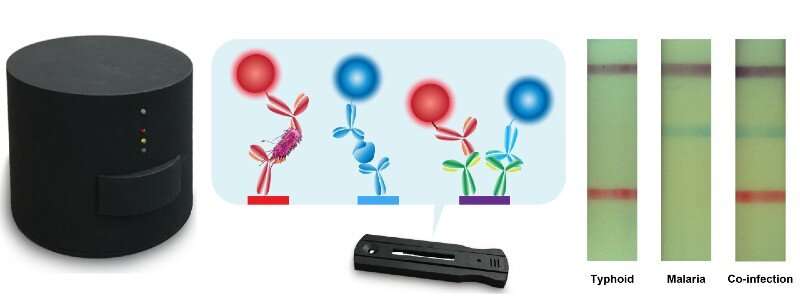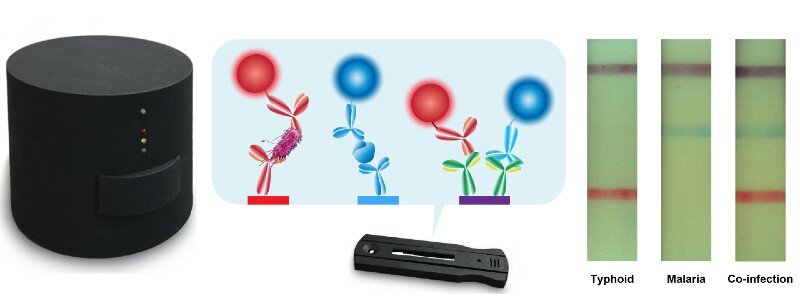Rapid test delineates diseases with similar symptoms

Malaria and typhoid fever are major health problems in tropical regions, but accurate diagnosis is often hampered by overlapping or nonspecific symptoms and limited access to diagnostics. Now, NIBIB-funded scientists have developed a single point-of-care assay that identifies malaria, typhoid—or both simultaneously—in just 15 minutes.
Each year, worldwide, more than 240 million cases of malaria account for approximately 600,000 deaths; 10 to 20 million cases of typhoid fever account for approximately 150,000 deaths. Both are febrile diseases (cause a high fever), which is often the reason an individual visits a clinic. Currently, most tests to determine which disease is present require sophisticated lab equipment and trained personnel that are not available in areas such as sub-Saharan Africa where there is a co-occurrence of malaria, typhoid, and poor healthcare infrastructure.
To address the problem scientists at Cornell University in Ithaca, New York have developed a hand-held test that combines the speed, accuracy and low cost necessary for practical use in the low-resource settings where the two diseases are pervasive and can even infect the same individual.
The Cornell group is a 10-year collaborative effort that aims to improve public health by creating inexpensive diagnostics that work at what the team describes as the point-of-need—anywhere in a community where rapid diagnosis can improve getting people into treatment. The collaboration was created by Dr. David Erickson, the Sibley College Professor at Cornell’s Sibley School of Mechanical and Aerospace Engineering, and Dr. Saurabh Mehta, the Janet and Gordon Lankton professor of global health, epidemiology and nutrition in the Division of Nutritional Sciences.
“The Cornell group specializes in point-of-care (POC) tests that can have a real impact in the developing world,” explained Tiffani Lash, Ph.D., director of the NIBIB program in Point-of-Care Technologies-Diagnostics. “This important test can be added to a growing list of their accomplishments that include POC tests that detect nutritional deficits, a number of infectious diseases, cholesterol levels, and even cancer.”
The new test which can identify whether a patient is infected with malaria, typhoid, or both is known as a lateral flow assay. Like pregnancy tests and COVID-19 home tests, swabs or fluids from a patient are placed on a test strip where they flow across the strip. The appearance of different colored lines indicates whether an infection is present. An important part of such tests is a control line that signals that the test was done properly.
The new assay was tested using human serum “spiked” with malaria and typhoid antigens as well as patient samples from several individuals. With samples containing antigens from both disease agents, the lateral flow assay produced a red line indicating typhoid, a blue line indicating malaria, and a purple control line. Additional clinical samples are being tested with the new assay to optimize the performance and sensitivity of the test.
A key innovative aspect of the technology is the skillfully engineered chemistry that allows the simultaneous detection of malaria and typhoid fever on a single test strip using just a few drops of serum—described as “duplex” because it can detect two diseases. Another innovation is an inexpensive hand-held optical reader, which has an extremely high sensitivity that can detect the lines that appear on the test strips that would not be clearly visible to the naked eye. A reader, which could serve and entire clinic costs about $70, with the individual tests running about $2 each.
“Ultimately diagnostics are about treatment—identifying the right disease to facilitate the right treatment and administering it as soon as possible,” explains Mehta. “For example, without an accurate diagnostic test, healthcare personnel in low-resource settings often have to resort to presumptive treatment. They may just treat for malaria, if it is more common in the region. However, if the individual has typhoid, the illness may get worse, and the time lost in correctly treating for typhoid can result in a critical situation.”
Another issue is the problem of the development of antibiotic resistance. Without diagnostics that allow for treatment with the most effective drug for the specific disease, the over-use of broader spectrum antibiotics eventually results in the development of antibiotic resistance, which can leave a population with no effective treatments for such diseases.
From the engineering side of things, Erickson explained the reasoning behind developing the hand-held reader that scans the test strips and displays the results. “We have developed a number of tests that use a reader that is attached directly to a smartphone, but out in the field individuals have different smartphones making it impractical to build a single piece of hardware—a reader—that can attach correctly to all smartphones.”
To address this problem, the team is developing a reader that will be able to communicate with all types of smartphones via Bluetooth. Although the current reader can simply display the test results, by building in the Bluetooth capability the test results can be added to an individual’s health record on their smartphone. Compiling such information can also be extremely valuable for tracking the spread of disease in a population and gathering other relevant information such as the emergence of disease variants that can be used to develop more effective public health programs.
Source: Read Full Article
